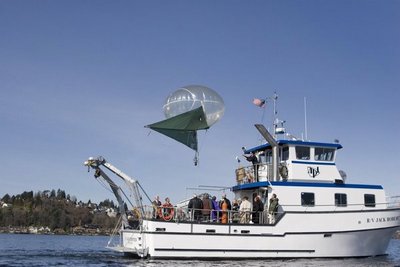April 30, 2009
UW scientists help with family event at Pacific Science Center
The Earth as revealed from satellites, other space craft and planes has been the subject of Pacific Science activities all month and concludes Saturday with hands-on activity stations involving UW scientists from eight units as well as Microsoft, Central Washington University and the National Weather Service.
The event will be from 10 a.m. to 6 p.m. and is aimed at families with children 8 and older.
Our ability to look at the Earth from above has transformed what we know about our home planet during the last 50 years, says the Pacific Science Center Web site at http://www.pacsci.org/earthrevealed/. Revealed are patterns such as hurricanes and features such as glaciers, volcanoes and oceans, it says.
UW units taking part are the Applied Physics Laboratory, Department of Astronomy, School of Oceanography, Department of Atmospheric Sciences, Department of Earth and Space Science, Department of Electrical Engineering, the Joint Institute for the Study of the Atmosphere and Ocean and the College of Forest Resources.
From forest resources, for example, Assistant Professor L. Monika Moskal and her graduate student Meghan Halabisky will explain how they use light from lasers on land and mounted on airplanes and satellites, as well as photography and satellite imagery, for ecosystem studies. Moskal uses the data to estimate the tree biomass of forests — a calculation that could be used, for instance, to figure how much carbon is being held in the forest and if that amount of carbon is increasing or decreasing as conditions change. Halabisky is checking wetlands to see how water balance and size changes during the seasons and over the long term.
Another example of an activity, this from the Applied Physics Laboratory, gives kids the chance to use a joystick to control video and infrared cameras suspended from a helium “kite” floating in a high-ceiling area of the Pacific Science Center. The setup has been used to study such things as the mixing and velocity of river water and the energy of waves breaking in the ocean, says Andy Jessup, APL principal oceanographer. On Saturday, the cameras will be directed toward a pool of water below the kite. Taking shifts helping will be Jessup, oceanographer Ruth Branch, engineer Dan Clark and oceanographer Chris Chickadel.



